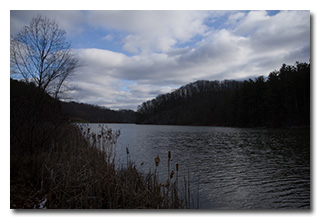
by William Eric McFadden
From the Strouds Run State Park website:
-
Strouds Run State Park is located in the scenic forested hills of Athens County, in the midst of the unglaciated Appalachian Plateau. Although untouched by the vast ice sheets that moved across portions of the state over 12,000 years ago, Strouds Run displays the effects of the glaciers -- in the deep ravines and high hills -- where the valleys served as outlets for torrents of glacial meltwaters. The erosive power of these waters carved the valleys and hillsides, creating the familiar topography Ohioans know today. Large deposits of glacial outwash, primarily sand and gravel, were deposited along these streams and strongly affected the type of biological communities present today.
Pictures
Description
On Sunday, December 18, 2022, one member of the Southeast Ohio Radio Adventure Team performed a successful activation of Strouds Run State Park (K-1994) as part of the Parks on the Air (POTA; link) program.
On his quest to earn the Fox Den Repeater Offender Activator Award for forty activations of the park, on a partly-sunny, 32° December afternoon, Eric McFadden, WD8RIF, returned to Bulldog Shelter within Strouds Run State Park for his thirty-fifth POTA activation of the park. Eric was accompanied by the little dogs Theo and Ginny.
 Eric arrived at Bulldog Shelter at about 1815 UTC, somewhat disappointed to find that there was almost no
snow cover at this portion of the park; Eric's QTH less than four miles away as-the-crow-flies had about half
an inch of snow on the ground from the season's first significant snowfall.
Eric arrived at Bulldog Shelter at about 1815 UTC, somewhat disappointed to find that there was almost no
snow cover at this portion of the park; Eric's QTH less than four miles away as-the-crow-flies had about half
an inch of snow on the ground from the season's first significant snowfall.
Eric parked his car at one end of the small parking lot, and deployed his 28½' wire vertical on his 31' Jackite fiberglass telescoping mast on his drive-on base. Because of the cold temperature, Eric deployed his Elecraft KX3 inside his car and was on the air at 1831 UTC.
As expected, Eric found he had good cell-signal at this location and he would be able to spot himself on the POTA Spots website and to use POTA Spots to identify possible Park-to-Park (P2P) QSOs.
Eric's plan had been to try to validate this activation by making his first ten QSOs solely on 15m.
Eric began his operation on 15m by finding himself a frequency to run and calling CQ, and was pleased to be auto-spotted on POTA Spots. Eric's first QSO came at 1837 UTC with KJ7DT in Idaho. QSOs came slowly but steadily, with Eric's fifth QSO coming at 1848 UTC with KE0DNL in Colorado. This run included QSOs with stations in Idaho, California, Washington (2), and Colorado. It is humorous to note that right after Eric's third QSO, little dog Ginny forced her way onto his lap and stayed there until Eric was no longer able to write on his log and was forced to remove her from his lap so he could continue his activation.
When Eric realized 15m wasn't going to deliver the ten QSOs required to validate his activation, he checked POTA Spots for P2P QSO opportunities. At 1853 UTC, he made a P2P QSO on 20m with NA9M who was activating Leopold Wetland Management District (K-0602) in Wisconsin. This was followed at 1859 UTC by a P2P QSO on 40m with KD8BBK who was activating Jackson Bog State Nature Preserve (K-9415) in Ohio.
Finding himself a frequency on 20m to run, Eric began calling CQ and updated his spot on POTA Spots. His first QSO in this run came at 1902 UTC with N4WN in Florida. QSOs came quickly, with Eric's nineteenth QSO in this run coming at 1920 UTC with N8EYF in Florida. This run included a P2P QSO with N9MM who was activating Sam Houston National Forest (K-4417) in Texas and QSOs with operators located in Florida (5), Minnesota (2), Idaho, Colorado, Texas, New Mexico, Mississippi, Maine, Georgia (2), New Hampshire, Tennessee, South Carolina, and California.
Eric finished his activation by again checking POTA Spots for P2P QSO opportunities. At 1925 UTC, he made a P2P QSO on 30m with K0BWR who was activating Prairie State Park (K-1770) in Montana and at 1927 UTC he made a P2P QSO on 40m with N4NTO who was activating Tar River State Game Land (K-6956) in North Carolina.
In all, Eric made twenty-eight QSOs, including five P2P QSOs, in just about fifty minutes of operating time. All of Eric's QSOs were CW and were made at five watts output.
Eric also submitted his log to the World Wide Flora and Fauna in Amateur Radio (WWFF; link) program for an operation at Strouds Run State Park, KFF-1994.
(return)